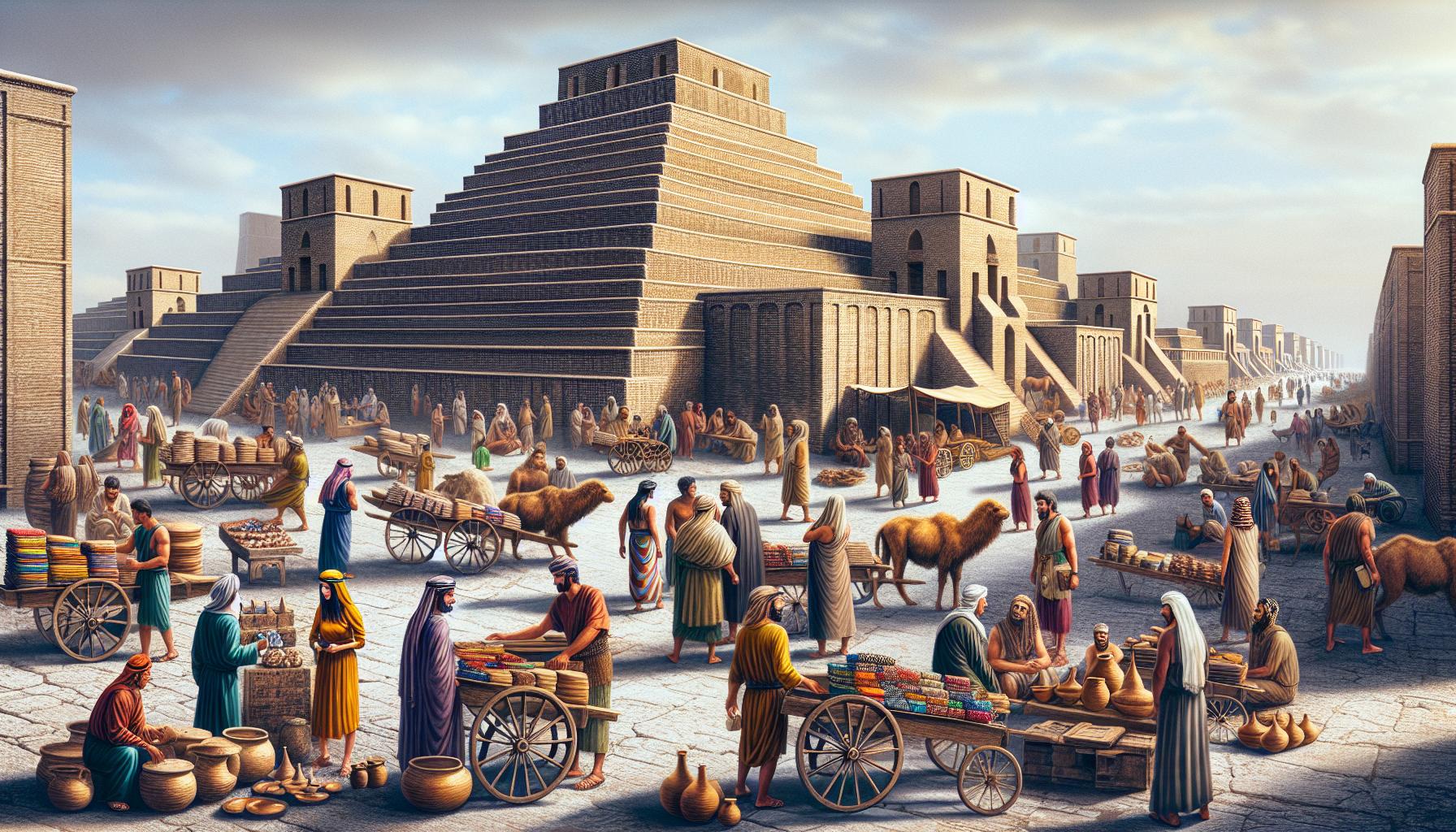Have you ever stopped to ponder how the humble wheel revolutionized ancient trade routes and commerce? Imagine a time when goods were transported over vast distances without the aid of this ingenious invention. The wheel, a simple yet transformative creation, played a pivotal role in shaping the landscape of ancient trade networks.
In this article, we delve into the significance of the wheel in facilitating trade during ancient times. From the Mesopotamian civilization to the Roman Empire, the wheel served as a catalyst for economic growth and cultural exchange. By enabling the movement of goods with greater efficiency, the wheel not only connected distant regions but also laid the foundation for the development of complex trading systems.
Join us on a journey through history as we explore how the wheel’s invention forever changed the dynamics of ancient trade, paving the way for interconnected economies and the exchange of goods across continents.
Evolution of the Wheel
From its humble beginnings as a pivotal Mesopotamian invention, the wheel evolved to become one of the most influential prehistoric transportation tools in ancient times. Sumerian technological advancements played a crucial role in the development of this ancient engineering marvel, laying the foundation for the origins of the wheel as we know it.
The wheel’s significance extended beyond mere transportation, as evidenced by its integration into various aspects of daily life in ancient civilizations. Mesopotamian pottery wheels, for example, revolutionized pottery creation, showcasing the versatility and practicality of this innovation. The wheel’s impact on ancient civilizations transcended mere functionality, touching upon realms of symbolism and cultural significance.
Ancient engineering feats such as the Egyptian chariot history highlight the adaptability of the wheel in different contexts, further solidifying its place in the annals of history. Mesopotamian innovations in wheel development not only improved transportation efficiency but also contributed to the growth of interconnected trade networks.
The widespread use of wheeled vehicles in ancient times, including in wheeled warfare, demonstrated the practical applications and strategic advantages offered by this ancient technology. Mesopotamian wheel diffusion facilitated the spread of this innovation across regions, paving the way for increased cultural exchange and economic prosperity.
As archaeologists uncover more about ancient wheel materials and Mesopotamian wheel archaeology, we gain a deeper understanding of the technological prowess and ingenuity of ancient civilizations. The wheel’s role in ancient trade was pivotal, facilitating the movement of goods, connecting distant regions, and shaping the economic landscapes of the time.
In exploring the evolution of the wheel, we delve into a fascinating journey through time, tracing the ancient roots of this enduring symbol of innovation and progress. The wheel truly stands as a testament to human ingenuity and the transformative power of technological advancements in shaping the course of history.
Impact on Ancient Trade Routes

The wheel’s significance reverberates through the annals of history, particularly in its impact on ancient trade routes. Imagine ancient civilizations like Mesopotamia and the Roman Empire interconnected through trade networks facilitated by wheeled vehicles. Mesopotamian Invention of the wheel ignited a revolution in transportation that accelerated the exchange of goods across vast distances.
Prehistoric Transportation systems relied on simple tools until the introduction of the wheel, marking a turning point in ancient commerce. Ancient Engineering Marvels like the wheel transformed how goods were transported, fostering economic prosperity and cultural exchange between distant civilizations.
Sumerian Technological Advancements played a pivotal role in refining the wheel into a practical tool for trade. The Origins of the Wheel can be traced back to Mesopotamia, where innovative minds conceptualized this groundbreaking invention.
In ancient Egypt, the use of wheeled vehicles expanded, notably in Egyptian Chariot History, showcasing the wheel’s adaptability to various modes of transportation. Mesopotamian Innovations in wheel development further solidified its status as a crucial element in the movement of goods.
The wheel’s integration into daily life, including Mesopotamian Pottery Wheels and its role in Ancient Wheeled Warfare, underscores its versatility beyond trade. Mesopotamian Wheel Symbolism also reflects the cultural significance attached to this ingenious invention.
Archaeological findings shed light on Mesopotamian Wheel Archaeology and the materials used in ancient wheels, highlighting the technological prowess of early civilizations. The wheel’s legacy in shaping Wheel’s Role in Ancient Trade endures, emphasizing its lasting impact on commerce and connectivity across ancient societies.
Through advancements in Mesopotamian Wheel Innovations, ancient trade routes flourished, laying the foundation for future economic interactions. The wheel’s journey from a humble invention to a cornerstone of ancient trade showcases the ingenuity and foresight of our ancestors in shaping the landscapes of commerce.
Influence on Trade Commodities
The wheel’s role in ancient trade was pivotal, significantly impacting the exchange of goods and commodities across vast distances. Its introduction transformed the way ancient societies conducted commerce and facilitated the movement of various products. Let’s delve into how the wheel influenced trade commodities in ancient civilizations.
Mesopotamian Invention of the Wheel:
In Mesopotamia, the invention of the wheel revolutionized transportation and trade. The Mesopotamians were among the first to develop wheeled vehicles, allowing for the efficient movement of goods such as grains, textiles, and pottery. These innovations led to the establishment of trade routes that connected Mesopotamia with other regions, enhancing the exchange of commodities.
Sumerian Technological Advancements and Trade:
The Sumerians, an ancient Mesopotamian civilization, significantly advanced wheel technology for trade purposes. Their improvements in wheel design and construction played a crucial role in enhancing the transportation of trade commodities. As a result, Sumerian goods like metals, agricultural products, and textiles became sought-after items in trade networks across the ancient world.
Egyptian Wheel Adaptations for Trade:
In ancient Egypt, the adoption of wheeled vehicles for trade further demonstrated the widespread impact of the wheel on commerce. Egyptian chariots were not only utilized for warfare but also for transporting commodities such as precious metals, spices, and grains. The efficient movement of goods using wheeled vehicles facilitated trade relationships with neighboring regions and enabled the Egyptians to access a variety of trade commodities.
Wheel’s Symbolism in Ancient Trade:
Beyond its practical applications, the wheel held symbolic significance in ancient trade. Representing progress, connectivity, and prosperity, the wheel became a powerful symbol of trade relationships and economic growth. Its presence in the transportation of commodities symbolized the interconnectedness of ancient civilizations and the flourishing trade networks that spanned vast distances.
Legacy of the Wheel in Ancient Trade:
The legacy of the wheel in ancient trade routes endures as a testament to its lasting impact on commerce and cultural exchange. From Mesopotamian innovations to Egyptian adaptations, the wheel’s influence on the movement of trade commodities shaped ancient civilizations and contributed to the development of extensive trade networks that connected distant regions.
Technological Advancements
Mesopotamian Invention and Sumerian Technological Advancements were instrumental in shaping the origins of the wheel. The development of Ancient Engineering Marvels such as the wheel marked a significant milestone in Prehistoric Transportation. Ancient civilizations like the Sumerians not only introduced innovative concepts but also refined Prehistoric Transportation methods to improve trade and commerce.
In Mesopotamia, the advancement of Mesopotamian Wheel Development led to the creation of the earliest wheeled vehicles. These innovations revolutionized transportation and played a crucial role in the efficient exchange of goods along ancient trade routes. Mesopotamian Innovations in wheel technology facilitated the movement of commodities, transforming the economic landscape of the region.
Moreover, Mesopotamian Wheel Diffusion enabled the spread of this groundbreaking technology to neighboring civilizations, influencing Ancient Egyptian Wheel Usage and paving the way for Egyptian Chariot History. The integration of wheels into chariots enhanced mobility, transforming both warfare and trade in ancient times.
The significance of Mesopotamian Pottery Wheels and Ancient Wheeled Warfare cannot be understated. The application of the wheel in various industries, from pottery making to military strategies, showcased its versatility and practicality in different aspects of ancient societies.
Furthermore, the symbolic meaning of the wheel in Mesopotamian Wheel Symbolism transcended its physical utility. It represented progress, connectivity, and the interdependence of civilizations in the ancient world. Egyptian Wheel Adaptations further highlighted the adaptability of this technology across different cultures, emphasizing its enduring impact on Ancient Wheel Materials.
The wheel’s role in Ancient Trade was not just about transportation but also about fostering economic prosperity, cultural exchange, and technological advancements. Its legacy lives on in the archaeological discoveries of Mesopotamian Wheel Innovations, underscoring its lasting influence on ancient civilizations.
Conclusion
The wheel’s impact on ancient trade routes and commerce is undeniable. From its origins in Mesopotamia to its integration into chariots for warfare and trade in various civilizations, the wheel has played a pivotal role in shaping economic prosperity and cultural exchange. Its symbolic representation of progress and connectivity resonates throughout ancient societies, highlighting its enduring legacy. The technological advancements in wheeled vehicles and the diffusion of wheel technology have revolutionized trade commodities and transportation methods. The wheel’s versatility in pottery making and military strategies further emphasizes its significance in ancient trade. Overall, the wheel’s influence on ancient trade routes has fostered connectivity and facilitated the exchange of goods and ideas, contributing to the development of civilizations.
Frequently Asked Questions
What is the historical significance of the wheel in ancient trade routes?
The wheel had a significant impact on ancient trade routes, facilitating the movement of goods and connecting distant civilizations. From Mesopotamia to the Roman Empire, the wheel revolutionized transportation, enabling the efficient exchange of commodities and fostering economic prosperity.
How did the wheel influence trade commodities in ancient times?
The wheel played a crucial role in the trade of commodities by enhancing transportation efficiency and reducing travel time. Its introduction in Mesopotamia led to the development of wheeled vehicles, such as carts and chariots, allowing traders to transport goods over long distances more quickly and effectively.
What was the symbolic significance of the wheel in ancient trade?
In ancient trade, the wheel symbolized progress, connectivity, and interdependence among civilizations. Its invention and widespread adoption represented a technological advancement that transformed trade networks, strengthened cultural exchanges, and promoted economic growth across regions.
How did the wheel impact military strategies in ancient societies?
The integration of the wheel into chariots revolutionized military strategies in ancient societies by enhancing mobility and speed in warfare. Wheeled vehicles equipped with the chariot helped armies maneuver more effectively on the battlefield, changing the dynamic of conflicts and influencing military outcomes.
What was the enduring legacy of the wheel on ancient trade routes?
The enduring legacy of the wheel on ancient trade routes lies in its role as a catalyst for cultural exchange, economic development, and global connectivity. Its adoption across civilizations shaped trade networks, promoted intercultural interactions, and laid the foundation for the modern transportation systems we have today.
